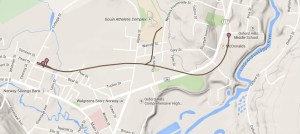PARIS — Gene Benner squinted his eyes in the sun, arms outstretched, trying to draw an imaginary line from where he stood on the asphalt sea behind Bessey Motor Sales’ showroom last summer, some 60 yards diagonally toward Main Street, the cemetery, and beyond.
“This is where it would be,” Benner said.
It’s June and Benner, owner of Bessey Motor Sales, stood on a stretch of pavement, once the site of rail beds owned and operated by the Norway Branch Railroad Co.
The line he’s describing no longer exists on the ground — the railroad bed has long been removed — but on paper, in taxes and land registry deed easements, it bisects his property.
Benner, like others a decade before him, is calling for the dissolution and sale of the Norway Branch Railroad Co., which was first incorporated in 1872. It owns roughly 1.5 miles of defunct rail from near Pine Street in Paris to the intersection of Beal and Cottage streets in Norway.
Like other businesses in Paris, Bessey Motor Sales potentially stands to gain from the dissolution of the rail because it would join two parcels he owns.
“If one day I want to sell, and Chrysler says ‘fine and dandy, but we want a new building,’ I can’t have a 60-foot imaginary line back there,” he said.
The businessman says the railroad, which hasn’t had passenger or freight rail service in over half a century by the railroad owner’s estimates, hinders economic development.
The issue came to light last summer, when Code Enforcement Officer Fred Collins briefly halted construction of a stand-alone Family Dollar store on Main Street because it was too close to Main Street (Route 26). The railroad owns 0.6 of an acre in a diagonal strip from the northwest to the southeast of the building, which forced construction to encroach upon the road.
According to Paris Town Manager Amy Bernard, difficulties contacting the company to obtain an easement were an “obstacle” to development of the store.
“I don’t know if it’s still a problem, but this time last year, it was an issue,” Bernard said.
After 140 years, the rail’s owner said he’s considering changing the corporation’s purpose in order to liquidate its assets. In response to Benner and others, Norway Branch Railroad Co. President Dennis Gray said Wednesday that the corporation began exploring changing its charted mission in August.
“Right now we’re in the process of putting together a way to get legal advice,” Gray said.
The rail line’s history starts with the state Legislature, which issued it a charter in 1870 and began leasing from Grand Trunk Railroad, and then eventually from St. Lawrence and Atlantic. Goods were delivered into the middle of the 20th century; the rail has not been used since.
The corporation continued, deriving revenue by leasing easements to businesses so they might cross it. Its current agreement with Family Dollar developer Hunt’s Real Estate is the only active agreement. The lease with Bessey expired over a decade ago, though it continues to drive cars over the easement, according to Benner.
Yet a sale isn’t a straightforward process, and will require the corporation to change its purpose under its charter and become more of a historic preservation society, Gray said. Benner has proposed to pay the legal fees for making the change. So far, he said he has not been taken up on the offer.
Benner is not the first to make this argument. Jack Shaner, former owner of Shaner’s Restaurant, which was torn down in April to make way for the Family Dollar store, called for the the railroad to sell its easements a decade ago, according to Sun Journal archives.
Other issues complicate the situation. To fund and ensure the longevity of the rail line, shares in the rail were sold around when it was created. Today, most shareholders can’t be found. The Town of Norway remains Norway Branch Railroad Co.’s majority shareholder, meaning that any land sale would have to be approved by a majority of residents by vote at a town meeting.
Yet, sales aren’t without precedent. In 1985, Norway Branch Railroad Co. sold a piece of land near the intersection of Beal and Cottage streets to Robert Bahre, who eventually built subsidized apartments on the premises. In 1992, Norway considered selling its stocks to launch a business incubator.
In 1994, the company donated 1,700 feet of rail between Beal and Fern streets to the Maine Narrow Gauge Co. and Museum, according to Sun Journal archives.
Both Benner and Shaner said the fact that they don’t own the land exposed them to risk if they wanted to expand. At different points, both business owners were interested in constructing new buildings, but deferred.
In the past, Gray said he opposed selling any part of the railway to Bessey or other abutters because it would break up the contiguous line, effectively ending hopes of restarting a luxury commuter rail service. Additionally, he said sale of the company would result in the state obtaining a piece of the land because many of the company’s stakeholders cannot be located, Gray said. He said previously the company’s cash assets were slightly over $60,000.
At the time of the Family Dollar deal, Gray said he was uninterested in selling. Now, after an annual meeting with board members, at which Benner and Shaner spoke, he said his position is evolving.
“It’s a for-profit corporation with stockholders mostly dead,” he said. “If we can make some accommodation, I think we’ll do that.”


Comments are no longer available on this story